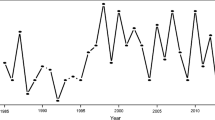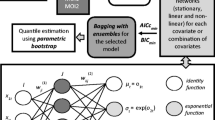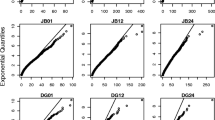Abstract
Studies carried out recently on hydrometeorological extremes report the evidence of non-stationarity induced by potential long-term climatic fluctuations and anthropogenic factors. A critical examination of the stationarity assumption has been carried out and a non-stationary generalised extreme value model with cyclic covariate structure for modelling magnitude and variation of data series with some degrees of correlation for real-world applications is proposed. Interestingly, the sinusoidal function with periodicity around 30 yr has been derived as a suitable covariate structure to deal with the ambiguous nature of temporal trends and this could possibly be linked to ‘Sun cycles’. It has adequately explained the cyclic patterns recognised in the annual rainfall which are helpful for realistic estimation of quantiles. Various diagnostic plots and statistics support the usefulness of the proposed covariate structure to tackle potential non-stationarities in the data characterising extreme events in various fields such as hydrology, environment, finance, etc.








Similar content being viewed by others
References
Agilan V and Umamahesh N V 2015 Detection and attribution of non-stationarity in intensity and frequency of daily and 4-h extreme rainfall of Hyderabad, India; J. Hydrol. 530 677–697.
Akaike H 1974 A new look at the statistical model identification; IEEE Trans. Autom. Control 19 716–723.
Brath A, Castellarin A and Montanari A 1999 Detecting non-stationarity in extreme rainfall data observed in Northern Italy; In: Proceedings of EGS – Plinius conference on Mediterranean storms, Maratea, pp. 219–231.
Brillinger D R 2001 Time series: Data analysis and theory; Society for Industrial and Applied Mathematics, Philadelphia, PA.
Chow V T, Maidment D R and Mays L W 1987 Applied hydrology (Civil Engineering Series), McGraw-Hill International editions.
Cohn T A and Lins H F 2005 Nature’s style: Naturally trendy; Geophys. Res. Lett. 32 L23402, https://doi.org/10.1029/2005GL024476.
Coles S 2001 An introduction to statistical modelling of extreme values; Springer, London.
Cox D R and Stuart A 1955 Some quick sign tests for trend in location and dispersion; Biometrika 42 80–95.
Cramer H 1946 Mathematical methods of statistics; Princeton Univ. Press, Princeton, NJ.
El Adlouni S, Ouarda T B M J, Zhang X, Roy R and Bobee B 2007 Generalized maximum likelihood estimators for the non-stationary generalized extreme value model; Water Resour. Res. 43 W03410.
Fisher R and Tippet L 1928 Limiting forms of the frequency distribution of the largest or smallest member of a sample; Proc. Cambridge Philos. Soc. 24 180–190.
Goswami B N, Venugopal V, Sengupta D, Madhusoodanan M S and Prince K X 2006 Increasing trend of extreme rain events over India in a warming environment; Science 314 1442–1445.
Helsel D R and Hirsch R M 1993 Statistical methods in water resources; Elsevier, https://www.elsevier.com/HrBbooks/statistical-methods-in-water-resources/helsel/978-HrB0-444-88528-9.
Hurst H E 1951 Long-term storage capacity of reservoirs; Trans. Trans Am. Soc. Civil Eng. 116 770–808.
Jagtap R S 2014 Effect of record length and recent past events on extreme precipitation analysis; Curr. Sci. 106(5) 698–707.
Jagtap R S, Roy S K, Mathew F T and Pawar P K 2011 Entropy based assessment of rain gauge network in a river basin; J. Appl. Hydrol. 24(1&2) 74–85.
Jain S and Lall U 2001 Floods in a changing climate: Does the past represent the future? Water Resour. Res. 37 3193–3205.
Jenkinson A F 1955 The frequency distribution of the annual maximum (or minimum) values of meteorological elements; Quart. J. Roy. Meteorol. Soc. 81 158–171.
Katz R W 2010 Statistics of extremes in climate change; Clim. Change 100 71–76, https://doi.org/10.1007/s10584-010-9834-5.
Kendall M G 1970 Rank correlation methods (4th edn), Charles Griffin, London.
Klemes V 1974 The Hurst phenomenon: A puzzle? Water Resour. Res. 10(4) 675–688.
Koutsoyiannis D 2006 Non-stationarity vs. scaling in hydrology; J. Hydrol. 324(1–4) 239–254.
Koutsoyiannis D and Montanari A 2007 Statistical analysis of hydroclimatic time series: Uncertainty and insights; Water Resour. Res. 43 w05429.
Kunkel K E, Karl T R and Easterling D R 2007 A Monte Carlo assessment of uncertainties in heavy precipitation frequency variations; J. Hydrometeorol. 8 1152–1160.
Lins H F and Cohn T A 2001 Stationarity: Wanted dead or alive? J. Am. Water Res. Assoc. JAWRA 47(3).
Lopez J and Frances F 2013 Non-stationary flood frequency analysis in continental Spanish rivers using climate and reservoir indices as external covariates; Hydrol. Earth Syst. Sci. 17 3189–3203, https://doi.org/10.5194/hess-17-3189-2013.
Maidment D R 1993 Handbook of hydrology; McGraw-Hill Professional, New York.
Mann H B 1945 Non-parametric tests against trend; Econometrica 13 245–259.
Matalas N C 1997 Stochastic hydrology in the context of climate change; Clim. Change 37 89–101.
Milly P C D, Betancourt J, Falkenmark M, Hirsch R M, Kundzewicz Z W, Lettenmaier D P and Stouffer R J 2008 Stationarity is dead: Whither water management? Science 319 573–574.
Mondal A and Mujumdar P P 2015 Modeling non-stationarity in intensity, duration and frequency of extreme rainfall over India; J. Hydrol. 521 217–231.
Pettitt A N 1979 A non-parametric approach to the change point problem; J. R. Stat. Soc. C Appl. Stat. 28 126–135.
Pryor S C, Howe J A and Kunkel K E 2009 How spatially coherent and statistically robust are temporal changes in extreme precipitation in the contiguous USA? Int. J. Climatol. 29 31–45.
R Core Team 2015 R: A language and environment for statistical computing; R Foundation for Statistical Computing, Vienna, Austria, https://www.R-project.org/.
Rigby R A and Stasinopoulos D M 2005 Generalized additive models for location, scale and shape; J. R. Stat. Soc. Ser. C Appl. Stat. 54 507–554.
Roxy M K, Ghosh S, Amey P, Athulya R, Milind M, Raghu M, Pascal T and Rajeevan M 2017 A threefold rise in widespread extreme rain events over central India; Nat. Commun. 8 708, https://doi.org/10.1038/s41467-017-00744-9.
Serinaldi F and Kilsby C G 2015 Stationarity is undead: Uncertainty dominates the distribution of extremes; Adv. Water Res. 77 17–36.
Shashikantha K and Prashanthi M 2017 Modeling of extreme rainfall projections of Indian monsoon under climate change; Indian J. Sci. Res. 15(2) 15–19.
Singh J, Vittal H, Singh T, Karmakar S and Ghosh S 2015 A framework for investigating the diagnostic trend in stationary and nonstationary flood frequency analyses under changing climate; J. Clim. Change 1(1–2) 47–65.
Singh J, Vittal H, Karmakar S, Ghosh S and Niyogi D 2016 Urbanization causes nonstationarity in Indian summer monsoon rainfall extremes; Geophys. Res. Lett. 43(21).
Smith R L 1985 Maximum likelihood estimation in a class of non-regular cases; Biometrika 72 67–90.
Villarini G, Serinaldi F, Smith J A and Krajewski W F 2009 On the stationarity of annual flood peaks in the continental United States during the 20th century; Water Resour. Res. 45 W08417, https://doi.org/10.1029/2008WR007645.
van Nooijen R R P and Kolechkina A G 2012 Estimates of extremes in the best of all possible worlds; In: 3rd STAHY international workshop on statistical methods for hydrology and water resources management, 1–2 October, Tunis, Tunisia.
Von Mises R 1954 The distribution of the greatest values of \(n\); American Math. Soc.: Providence RI II 271–294.
Wald A and Wolfowitz J 1943 An exact test for randomness in the non-parametric case based on serial correlation; Ann. Math. Stat. 14(4) 378–388.
Acknowledgements
Authors wish to thank the Director, CWPRS, Pune, for encouragement and continuous support.
Author information
Authors and Affiliations
Corresponding author
Additional information
Corresponding editor: Subimal Ghosh
Rights and permissions
About this article
Cite this article
Jagtap, R.S., Gedam, V.K. & Kale, M.M. Generalised extreme value model with cyclic covariate structure for analysis of non-stationary hydrometeorological extremes. J Earth Syst Sci 128, 14 (2019). https://doi.org/10.1007/s12040-018-1033-1
Received:
Revised:
Accepted:
Published:
DOI: https://doi.org/10.1007/s12040-018-1033-1




